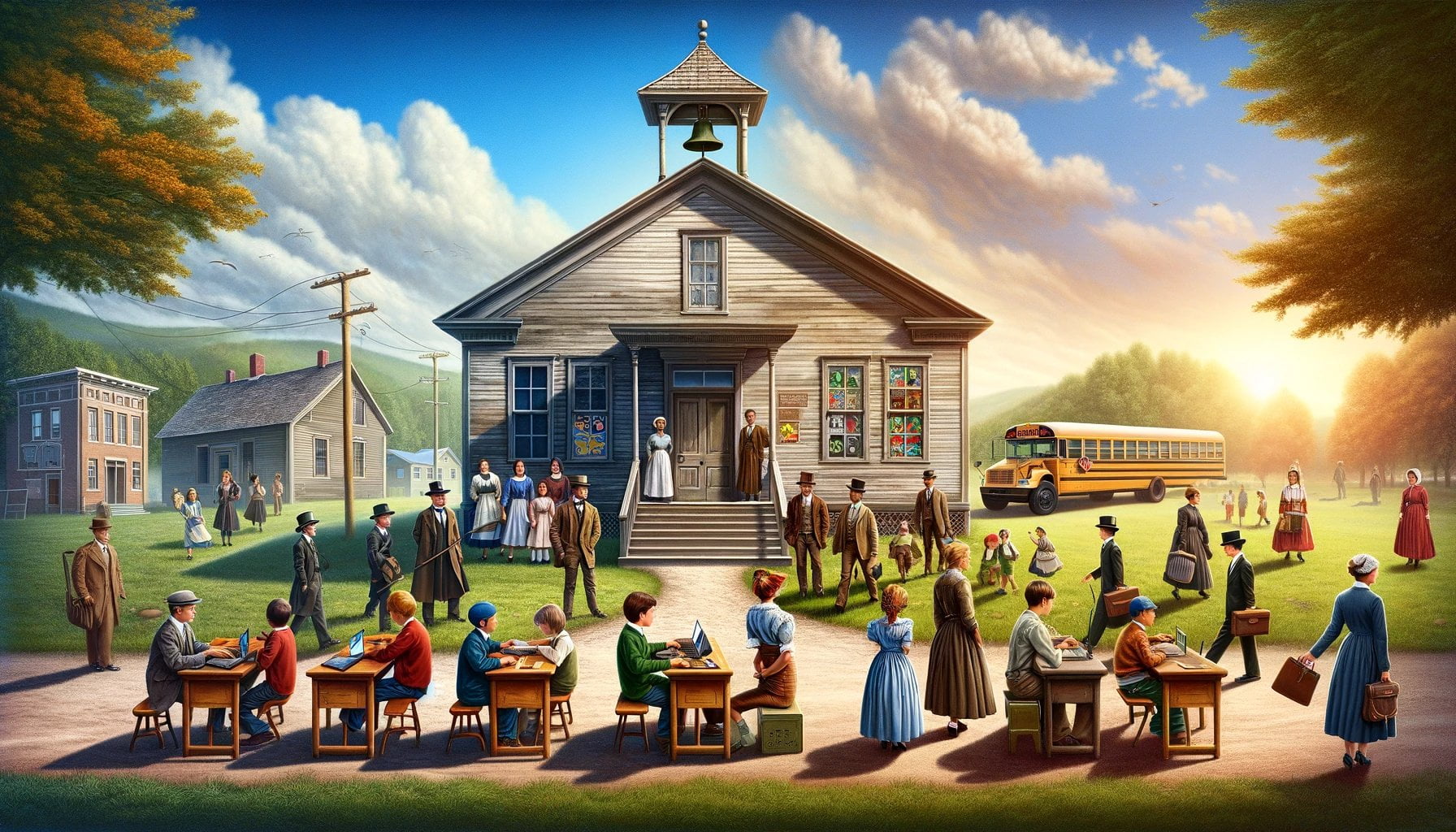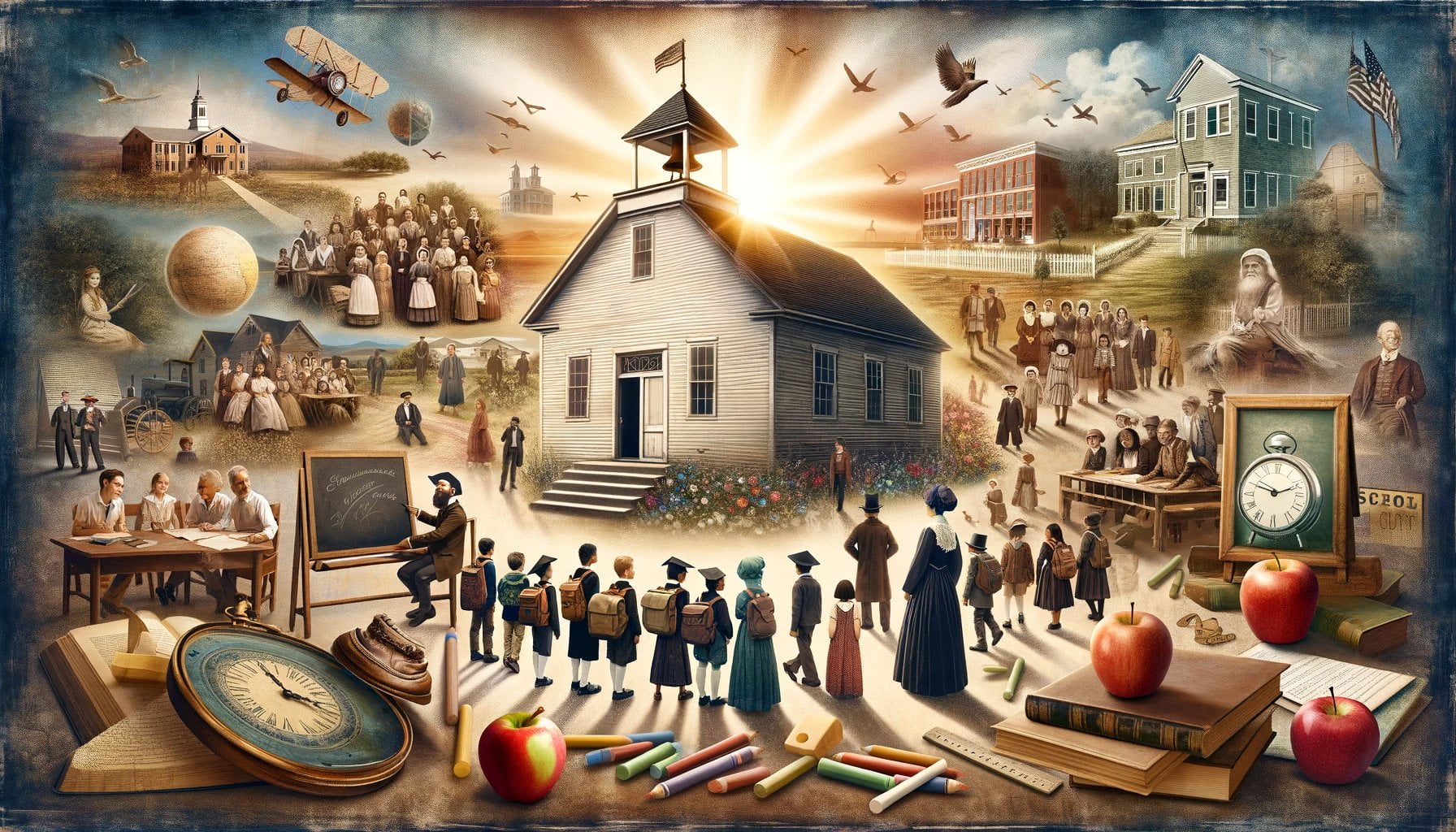Exploring the historical trajectory of education in America unveils a captivating tale of evolution and impact on society. Delving into the depths of this subject matter, we unearth eleven intriguing facts that shed light on the development and transformation of education in the United States. From pioneers who championed educational reform to pivotal moments that shaped the course of learning, these carefully curated facts provide a comprehensive understanding of the fascinating journey that education in America has undertaken.
Key Takeaways:
- The first schools in the 13 colonies opened in the 17th century.
- Early public schools in the United States did not focus on academics like math or reading.
- Girls were usually taught how to read but not how to write in early America.
- By the mid-19th century, academics became the sole responsibility of public schools.
- The Boston Latin School became the first school to open in the thirteen colonies in 1635.
- Public schools in the United States initially focused on values like family, religion, and community.
- Harvard was the first school for higher education.
- Public schools were not prevalent in the South during the 1600s and the early 1700s.
11 Fascinating Facts about the History of Education in America

Fact 1: The Establishment of the First Schools in the 13 Colonies (17th Century)
In the early days of American history, the concept of education was already taking root. The first schools emerged in the 17th century within the 13 colonies. These schools were often small, simple establishments where children were taught basic skills like reading, writing, and arithmetic[^1^].
Fact 2: Focus on Values Instead of Academics in Early Public Schools
Contrary to popular belief, early public schools in the United States did not prioritize academic subjects like math or reading. Instead, their main objective was to instill values such as religious beliefs, family values, and a sense of community in students. Education during this period was centered around building character and developing moral uprightness[^1^].
Fact 3: Gender Disparity in Early American Education
In the early years, girls received education focused primarily on reading, while writing was not considered essential for them. This disparity often stemmed from societal expectations and traditional gender roles prevalent during that time[^1^].
Fact 4: Transformation of Public Schools in the Mid-19th Century
As America grew and developed, so did its educational system. By the mid-19th century, the responsibility of providing academic education shifted from private institutions to public schools. With this transition, public schools became the primary avenue for American children to receive a comprehensive education in various subjects such as math, science, and history[^1^].
Fact 5: Boston Latin School: The First School in the Thirteen Colonies (1635)
Founded in 1635, the Boston Latin School holds the honor of being the first educational institution to open within the thirteen colonies. This eminent institution set the stage for the widespread establishment of schools and the promotion of learning across America[^1^].
Fact 6: Core Values as the Foundation of Early Public Schools
During their early development, public schools in the United States placed emphasis on teaching values that formed the backbone of society. These moral and ethical principles included family values, religious teachings, and fostering a sense of unity and community among students[^1^].
Fact 7: Harvard University: Pioneering Higher Education
The establishment of Harvard University in 1636 marked a significant milestone in American education. Being the first higher education institution in America, Harvard provided an avenue for advanced learning and paved the way for the countless universities and colleges that followed[^2^].
Fact 8: Limited Prevalence of Public Schools in the South
While public schools gradually became more widespread in the 1600s and early 1700s, they were not as prevalent in the southern regions of America during this period. The education system in the South was largely reliant on private tutors and home-based education[^1^].
Fact 9: Shifting Patterns in Education During the 18th and 19th Centuries
Throughout the 18th and 19th centuries, education in America saw significant changes. The rise of industrialization and the need for an educated workforce led to an increased emphasis on practical subjects such as math, science, and vocational training. This shift mirrored the changing needs of a rapidly evolving society[^1^].
Fact 10: The Emergence of Normal Schools for Teacher Education
During the 19th century, normal schools emerged in America. These institutions specialized in training teachers, providing them with the necessary skills and knowledge to effectively educate students. Normal schools were instrumental in improving the quality of education across the nation[^1^].
Fact 11: The Formation of Land Grant Colleges (1862)
The passage of the Morrill Land-Grant Act in 1862 led to the establishment of land grant colleges across America. These institutions focused on practical education and aimed to promote agricultural and mechanical arts. The creation of these colleges expanded access to higher education and introduced a greater diversity of subjects into the curriculum[^1^].
By delving into the history of education in America, we gain valuable insights into how our educational system has evolved over time. As we reflect upon these 11 captivating facts, we can appreciate the remarkable journey that education has undertaken in shaping the nation and its future generations.
[Table]
[Markdown Table]
Fact Description 1 The first schools in the 13 colonies opened in the 17th century 2 Early public schools in the United States did not focus on academics like math or reading 3 Girls were usually taught how to read but not how to write in early America 4 By the mid-19th century, academics became the sole responsibility of public schools 5 The Boston Latin School became the first school to open in the thirteen colonies in 1635 6 Public schools in the United States initially focused on values like family, religion, and community 7 Harvard was the first school for higher education 8 Public schools were not prevalent in the South during the 1600s and the early 1700s 9 Transformation of education during the 18th and 19th centuries 10 The emergence of normal schools for teacher education 11 The formation of land grant colleges (1862)
Check out the Citizenship Just the Facts Answer Key for all the essential information you need to know about citizenship. citizenship just the facts answer key
Discover interesting facts about Adriana C. Ocampo, a fascinating individual who has made significant contributions in her field. adriana c. ocampo interesting facts
Explore 10 intriguing facts about Alma Thomas, an influential artist known for her unique style and contributions to the art world. 10 facts about alma thomas
Learn 3 fascinating facts about Thurgood Marshall, a trailblazer and the first African American Supreme Court Justice. 3 facts about thurgood marshall
The Role of Horace Mann in Shaping Modern Education
Horace Mann, often regarded as the father of public education in the United States, played a significant role in shaping the modern education system. His ideas and methods were groundbreaking, but also controversial, as they deviated from traditional educational practices. Let’s delve into how Mann worked to dismantle traditional education and introduce his own ideas.
Utopian Beliefs: A Departure from Tradition
Mann’s educational ideologies were influenced by the Utopian beliefs of a communist named Robert Owen. Unlike the prevailing influence of Christianity and the Reformation on the spread of education, Mann rejected the Bible and Orthodox teachings. Instead, he advocated for a more secular and collectivist approach to education. This departure from traditional religious teachings and values was a defining characteristic of Mann’s educational philosophy.
Redefining the Purpose of Education
Mann is often credited as one of the founders of public education in the United States. Prior to his efforts, education was mostly conducted within private or religious institutions. Mann sought to change this by advocating for a publicly funded and universally accessible education system. He firmly believed that education should be free, nonsectarian, democratic, and accessible to all. Mann’s vision aimed to offer equal opportunities to students, regardless of their background or socioeconomic status.
The Impact of Mann’s Reforms
As the Secretary of Education, Mann implemented several revolutionary changes. One of his significant accomplishments was the establishment of the first public normal school in the United States in Lexington. He also introduced measures to improve the quality of education, such as raising teacher salaries and lengthening the school year. Mann’s reforms prioritized standardized teaching methods and a more centralized approach to education administration.
Criticisms and Controversies
Despite his contributions to public education, Mann’s ideas and methods faced criticism. Some argued that his rejection of traditional religious teachings compromised the moral and spiritual aspects of education. Others contended that his collectivist approach undermined individualism and creativity in the classroom. Additionally, Mann’s reforms were accused of failing to address the diverse needs and abilities of students.
Key Takeaways:
- Horace Mann, the father of public education in the United States, played a significant role in shaping the modern education system.
- Mann’s educational philosophy deviated from traditional religious teachings and values, embracing a more secular and collectivist approach.
- He advocated for a publicly funded and universally accessible education system, offering equal opportunities to all students.
- Mann’s reforms included the establishment of the first public normal school, raising teacher salaries, and implementing standardized teaching methods.
- Criticisms of Mann’s approach revolve around compromising moral and spiritual aspects, undermining individualism and creativity, and neglecting diverse student needs.
Sources:
- Illinois Family Institute
- Study.com
The Introduction of Compulsory Education Laws
Education is a vital aspect of any society, and throughout history, the United States has undergone significant transformations in its approach to education. One crucial milestone in this journey was the introduction of compulsory education laws, which established the obligation for all children to attend school. Let’s explore 11 captivating facts about the history of education in America, specifically focusing on the introduction of compulsory education laws.
Fact 1: The Moral and Social Obligation
In 1642, the Massachusetts Bay Colony enacted the first compulsory education law in the United States. This law made education a moral and social obligation, emphasizing the importance of educating children to build a prosperous and well-functioning society.
Fact 2: Early Advocates for Free Public Education
The concept of compulsory schooling gained further momentum in the 19th century when advocates for free public education emerged. These advocates believed that education should be accessible to all children, regardless of their socioeconomic status, and that it played a crucial role in creating an informed citizenry.
Fact 3: Progression Towards Universal School Attendance
Although all states had passed school attendance legislation by 1918, enforcing compulsory schooling laws remained challenging until the 1930s. Factors such as the increase in population and demand for well-trained labor prompted the creation of bureaucratic machinery to enforce compulsory education effectively.
Fact 4: Constitutional Challenges
Opposition to mandatory schooling led to several court cases addressing constitutional issues. An important ruling came in 1972 in the case of Wisconsin v. Yoder, where the Supreme Court granted Amish parents the exemption from compulsory public school attendance beyond the eighth grade, considering religious freedom.
Fact 5: Age Requirements for School Attendance
Most states have compulsory education laws that require children between the ages of 6 and 16 to attend school. These laws seek to ensure that all children receive essential education in literacy, math, social studies, and science, providing them with a foundation for their future endeavors.
Fact 6: Unveiling Lesser-Known Facts
Exploring the history of compulsory education laws can uncover lesser-known facts that offer valuable insight into America’s educational journey. For more in-depth information, Michael S. Katz’s article “A History of Compulsory Education Laws” serves as a valuable resource.
Fact 7: To Learn More About Education in America
For a comprehensive understanding of the history of education in America, the American Board website (americanboard.org) offers 11 facts about this intriguing journey. It provides valuable information on various aspects of education, including the introduction of compulsory education laws.
Key Takeaways:
- The Massachusetts Bay Colony enacted the first compulsory education law in the United States in 1642, establishing education as a moral and social obligation.
- Advocates for free public education in the 19th century crusaded for compulsory schooling as a means to provide access to education for all children.
- By 1918, all states had adopted school attendance legislation, though enforcing compulsory education laws remained challenging until the 1930s.
- The increase in population and demand for well-trained labor led to the establishment of bureaucratic machinery for enforcing compulsory education.
- Court cases dealing with constitutional issues have arisen due to opposition to mandatory schooling, resulting in exemptions for certain religious groups.
- Most states have compulsory education laws that require children between the ages of 6 and 16 to attend school, ensuring they receive essential education in various subjects.
- Exploring the history of compulsory education laws can uncover lesser-known facts that contribute to our understanding of America’s educational journey.
- Michael S. Katz’s article “A History of Compulsory Education Laws” provides a more detailed examination of this topic.
- The American Board website (americanboard.org) offers 11 facts about the history of education in America, providing additional insight into this intriguing journey.
Educational Inequality and the Civil Rights Movement
Education has always played a pivotal role in shaping our society, and throughout history, educational inequality has been a pressing issue. The civil rights movement, in particular, shed light on the disparities in education and fought for equal opportunities for all. Let’s explore 11 captivating facts about the history of education in America, focusing on the intersection of educational inequality and the civil rights movement.
Fact 1: Desegregation of Education
Following the landmark Supreme Court decision in 1954, segregation in public schools was declared unconstitutional. The court ordered desegregation with “deliberate speed,” marking a significant victory in the civil rights movement. [^1]
Fact 2: Education and the Civil Rights Movement
Education has been a central issue in the civil rights movement. The movement gained momentum in 1954 after the Supreme Court made segregation illegal in public schools. This ruling struck a blow against discriminatory educational practices and fueled the fight for equal rights. [^2]
Fact 3: “Separate but Equal”
In 1896, the Supreme Court established the “separate but equal” doctrine for education. However, the South implemented only the “separate” part, leading to vast disparities in educational resources and opportunities. This unjust system persisted until it was challenged by the civil rights movement. [^1]
Fact 4: Racial and Economic Segregation
The persistence of racial and economic segregation has contributed significantly to educational inequality in America. Students from marginalized communities often face limited access to quality resources, experienced teachers, and adequately funded schools. This has perpetuated the achievement gap between different racial and socioeconomic groups. [^5]
Fact 5: Desegregation as a Major Goal
Desegregating public schools was a major goal of the civil rights movement. Activists fought tirelessly to dismantle the discriminatory policies that had long deprived Black students of equal educational opportunities. The movement’s efforts were instrumental in breaking down the barriers of segregation and paving the way for a more inclusive education system. [^6]
Fact 6: Educational Equity
Educational equity aims to ensure that all students, regardless of their circumstances, have equal access to opportunities to succeed. It focuses on addressing the systemic barriers that hinder marginalized students’ access to quality education. The civil rights movement played a pivotal role in pushing for educational equity and continues to inspire advocacy for fairness in our education system. [^7]
Fact 7: Widening Educational Gaps
The nexus of racial and economic segregation has widened educational gaps in America. Students from disadvantaged backgrounds often face additional obstacles, such as a lack of resources and support, that further hinder their educational attainment. This systemic issue continues to be a challenge in our ongoing pursuit of educational equality. [^8]
Fact 8: Impact of Civil Rights Laws
The federal civil rights laws enacted during the civil rights movement have greatly improved the educational opportunities of millions of students. These laws prohibited discriminatory practices and ensured that students of all races have equal access to education. They remain crucial in safeguarding the rights and dignity of individuals from historically marginalized communities. [^9]
Now that we have explored these captivating facts about the history of education in America, it is clear that the fight against educational inequality has been intricately connected to the civil rights movement. As we continue to strive for equal educational opportunities for all, let’s draw inspiration from the past and work towards building a more inclusive and equitable future.
Key Takeaways:
- The civil rights movement played a crucial role in the desegregation of public schools and the fight against educational inequality.
- Racial and economic segregation have contributed to disparities in educational resources and opportunities.
- Educational equity aims to provide equal access to opportunities for all students, regardless of their circumstances.
- The federal civil rights laws have significantly improved educational opportunities for millions of students.
- The fight for educational equality is an ongoing pursuit that requires constant advocacy and systemic change.
Sources:
– History Learning Site – Education and Civil Rights
– American Institutes for Research – Understanding Educational Inequality by Revisiting Civil Rights

FAQ
Q1: When did the first schools open in the 13 colonies in America?
A1: The first schools in the 13 colonies opened in the 17th century, according to the American Board Blog[^1^].
Q2: What subjects did early public schools in the United States focus on?
A2: Early public schools in the United States did not focus on academics like math or reading, as noted by the American Board Blog[^1^].
Q3: Did girls receive the same education as boys in early America?
A3: No, in early America, girls were usually taught how to read but not how to write, according to the American Board Blog[^1^].
Q4: Which school became the first to open in the thirteen colonies?
A4: The Boston Latin School became the first school to open in the thirteen colonies in 1635, according to the American Board Blog[^1^].
Q5: Were public schools prevalent in the South during the 1600s and early 1700s?
A5: No, public schools were not prevalent in the South during the 1600s and early 1700s, as stated by the American Board Blog[^1^].
- Unveiling the Enigma: Mansoureh Khojasteh Bagherzadeh’s Public Appearances & Private Life in Iran - July 18, 2025
- Unveiling the Mystery: Mansoureh Khojasteh Bagherzadeh’s Husband: A Rare Glimpse into a Private Life - July 18, 2025
- Unveiling Masoud Khamenei’s Mother: Power, Influence, and Iran’s Future - July 18, 2025
















